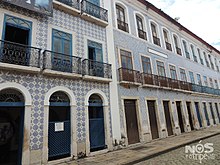 Historical Center of São Luís | |
| Duration | From the 18th to the 19th century |
|---|---|
| Location | Maranhão and Pernambuco, Brazil |
| Participants | Farmers, slaves, and the Portuguese
|
| Outcome | Economic expansion of the Captaincy of Maranhão; increase in slavery in Maranhão, and demographic changes |
The cotton cycle refers to the period when this product had great prominence in the Brazilian economy, especially in Maranhão and Pernambuco, between the mid-eighteenth to the beginning of the nineteenth century, being responsible for strong economic growth in the region. In the colonial period, cotton was also developed in the Captaincy of São Vicente, from where the product was exported to Rio de Janeiro and Bahia. Other regions produced it for local consumption and to manufacture cloth for slaves.[1]
This cycle developed in the context of an economic crisis in the colony with the end of the gold cycle and the competition of the sugar production in the northeast with the production in the Antilles, the beginning of the Industrial Revolution, and the War of Independence of the United States (main supplier of the product to England).[2]
- ^ "As Riquezas do Brasil Colonial e Sua Exploração". Enciclopédia Delta de História do Brasil (in Portuguese). Delta S/A. 1969. p. 1497.
- ^ Thales Augusto Zamberlan, Pereira (2017). Algodão e o Comércio Internacional do Brasil Durante a Revolução Industrial. USP (Thesis). Tese de Doutorado. doi:10.11606/T.12.2017.tde-17082017-091648.